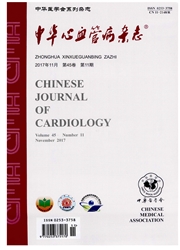

 中文摘要:
中文摘要:
目的 探讨外源性给予成纤维细胞生长因子(FGF) 21对载脂蛋白E基因敲除(apoE-/-)小鼠动脉粥样硬化(AS)的影响及可能的机制.方法 取17周龄C57 BL/6J小鼠12只作为空白对照组,将24只17周龄apoE-/-/小鼠采用随机数表法分为AS组和AS治疗组,每组各12只.采用皮下埋泵给药,AS治疗组给予FGF21(100 μg kg-1·d-1),其余2组给予等量生理盐水,给予高脂饮食喂养4周.药物干预4周后处死小鼠,分别于药物干预前和药物干预期间测定小鼠体质量和进食量.处死前微超声观察主动脉弓斑块面积及腹主动脉内径.药物干预4周后测定血脂及血浆中C反应蛋白(CRP)和肿瘤坏死因子(TNF)α的水平.用苏木素伊红、油红O染色观察主动脉弓内膜中膜厚度(IMT)及主动脉斑块面积.结果 对照组小鼠主动脉未发现明显AS病变.AS组小鼠复合血脂指标总胆固醇(TC)/高密度脂蛋白胆固醇(HDL-C)比值、低密度脂蛋白胆固醇(LDL-C)/HDL-C比值及非HDL-C值、血浆CRP和TNFα水平均高于对照组(P均<0.05).AS组小鼠主动脉IMT值高于对照组[(156.4±17.6) μm比(57.8±7.4) μm,P<0.05].AS治疗组主动脉弓斑块面积低于AS组[(1.42±0.16) mm2比(2.30±0.10)mm2,P<0.05],腹主动脉内径大于AS组[(0.97±0.03)mm比(0.75±0.18)mm,P<0.05];复合血脂指标TC/HDL-C(5.11±0.70比7.52±1.51)、LDL-C/HDL-C(3.90±0.76比5.77±1.27)及非HDL-C值[(6.33±1.22) mmol/L比(8.45±1.52)mmol/L]、血浆CRP[(4.20±1.03) mmol/L比(6.15±1.64) mmol/L]和TNFα[(1.29 ±0.47) mmol/L比(1.90±0.42)mmol/L]水平均低于AS组(P均<0.05).AS治疗组小鼠主动脉IMT值[(107.2±33.5) μm比(156.4±17.6)μm]、主动脉斑块面积[(14.26±3.5)%比(23.06±4.16)%]及主动脉根部斑块面积[(21.75±7.14)%比(38.03±5.76)%]均小于AS组(P均<0.05).结论 FGF21可以显著减轻AS病变,其机制可能是通过改善?
 英文摘要:
英文摘要:
Objective To explore the effects and related mechanisms of exogenous fibroblast growth factor(FGF) 21 on atheroselerosis in apolipoprotein E defcient(apoE-/-) mice. Methods Male 17-weekold C57BL/6J mice and apoE-/- mice were randomly divided into three groups (n = 12 each) : blank control group (C vehicle), atherosclerosis group without FGF21 (apoE-/- vehicle) and apoE-/- plus FGF21 (100 ug . kg-1. d-1 subcutaneously treatment). All mice were fed with high-fat diet for 4 weeks. After 4 weeks treatments, atheroselerotic lesions in aortic arch and inner diameter of abdominal aorta were measured by ultrasonography. Plasma lipid profiles, CRP and TNFa were measured. The whole aorta and aortic root were prepared for HE and oil red O staining to analyze lesion areas. Results There was no evident plaque in C vehicle group. TC/HDL-C, LDL-C/HDL-C, non-HDL-C, expression of CRP and TNFa were significantly higher in apoE-/- vehicle group than in C vehicle group (all P 〈0.05). IMT of aorta [ ( 156.4 ± 17.6) um vs. (57.8 ±7.4) um] were significantly higher in apoE-/- vehicle group than in C vehicle group ( all P 〈0. 05 ). While FGF21 significantly reduced the lesion area in aorta arch [ (1.42 ± 0. 16)mm2 vs. (2. 30 ± 0.10 )mm2,P〈0.05] and the inner diameter of abdominal aorta [(0.97 ±0.03)mm vs. (0.75 ±0. 18) mm,P 〈0. 05] compared to apoE-/- vehicle group. Similarly, TC/HDL-C(5.11 ± 0. 70) ,LDL-C/HDL-C (3.90 ±0. 76), non-HDL-C[ (6. 33 ± 1.22) mmol/L], plasma CRP[ (4. 20 ± 1.03) mmol/L] and plasma TNFa [(1.29±0.47) mmol/L] were also reduced by FGF21 ( all P 〈0.05 vs. apoE-/- vehicle). Moreover, FGF21 decreased the IMT[ ( 107. 2 ± 33.5 ) um vs. ( 156.4 ± 17.6 ) um ], lesion area of aorta [(14.26±3.5)%] vs. [(23.06±4.16)%] and plaque size of aorta root [(21.75 ±7.14)% vs. (38.03 ± 5.76) % ] ( all P 〈 0.05 vs. apoE-/- vehicle). Conclusions FGF21 can protect apoE-/- mice from atherosclerosis b
 同期刊论文项目
同期刊论文项目
 同项目期刊论文
同项目期刊论文
 Fibroblast growth factor 21 as a possible endogenous factor inhibits apoptosis in cardiac endothelia
Fibroblast growth factor 21 as a possible endogenous factor inhibits apoptosis in cardiac endothelia 期刊信息
期刊信息
